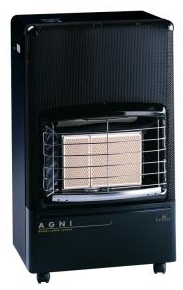I bought the first catalytic stove "Agni" in 2000. (I didn't want a ceramic insert - too small heating surface).
In March, CO fell on me and I had to wait until spring by heating a 17m2 room in the attic, with frosts reaching even around -10C. Gas consumption about 1 cylinder per week, with the stove on for about 8-10 hours. per day, of course, the furnace worked intermittently. I still use it to heat the room in spring and autumn. With such additional heating, the cylinder is enough for 1.5 months. At the start, I set the stove to the largest range III, so for 5 minutes to warm up the catalyst, and then it runs on the smallest range, in my opinion this is the best solution. Setting the stove to the 2nd or 3rd range is a waste of gas and money.
Because "Agni" was beating fire more and more at the start, due to a clogged catalyst, I decided to buy a second catalytic stove, this time from DeLonghi SC85.
I found that the heating surface of the catalyst is similar in both furnaces, so why overpay for "Agni".
I was wrong, because by heating up with the "DeLonghi SC85" stove, you can see higher gas consumption, 1 cylinder per month. The stove heats up less, I usually set it on the second range, and after 20-30 min. I'm just switching to the first range - the weakest heating. I have the impression that the heat somehow worse, spreads around the room. So, the "Agni" stove is better. I used to fall asleep with the stove on. It's hard to breathe at night, and I usually wake up because of it. It is true that the furnace also turned itself off due to the lack of oxygen in the air. Then the best ventilation is to open a door or window for a few moments to supply oxygen. Leaky windows and doors cannot provide enough fresh air to keep the stove burning. The temperature of the heated catalyst is about 300C, with its heating surface of about 42cm x 36cm, it is an interesting heating solution.
Certainly, it is much cheaper heating than heating with electricity.




